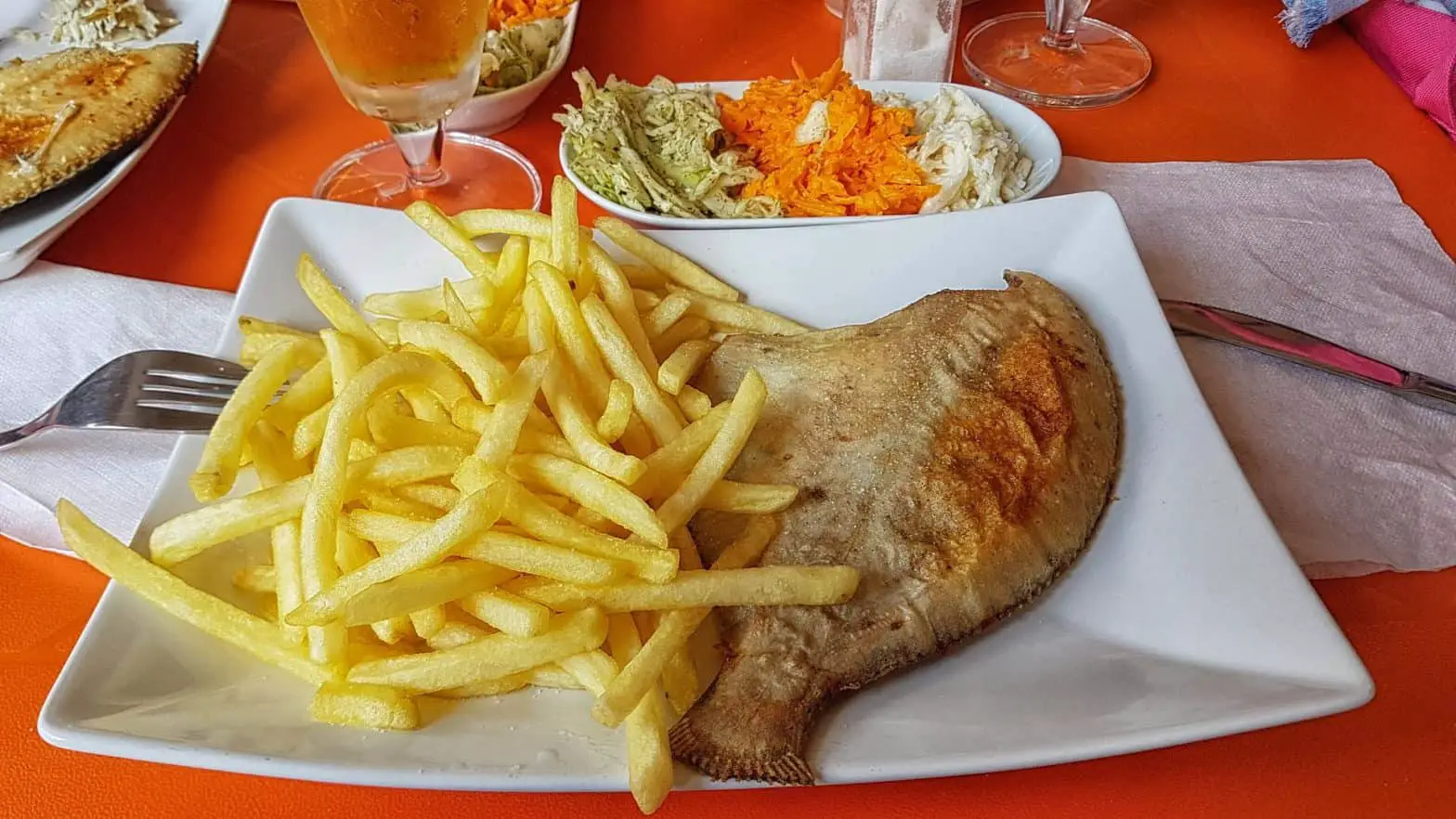Table of Contents
*This post may contain affiliate links. As an Amazon Associate we earn from qualifying purchases.
Halibut are just big flounder, right? Yes, and no. When it comes to comparing fish, halibut vs flounder may seem difficult at first. Both are flatfish that have a distinct look, so they can’t be mistaken for being some other fish species, and both are sought-after food fish, because they are delicious. Despite these shared characteristics, determining whether the fish on the end of your line is one or the other is easy, once you learn the details to look for in your game of halibut vs flounder.
What Is a Flounder?
‘Flounder’ refers to an entire group of flatfish, with over 200 species of flounder found all over the world. They go by different common names, but they are all bottom dwelling flatfish with both eyes on the top of their head. Found at the bottom of oceans, bays, and brackish water estuaries around the globe, these fish are camouflaged predators that feed on just about anything they can ambush from the sand.Flatfish hatch from their eggs with normal eye placement, on either side of the brain. As the baby flounderlings grow, they undergo a process of metamorphosis, which prompts one eye to migrate around to the top of the head. The exact spot where the eye comes to rest depends on the species, and some species can be determined by which side the second eye migrates to. The shape of the lateral line varies by species among flounder, with winter flounder and witch flounder showing a straight line, and yellowtail flounder and left-eyed windowpane flounder having quite curved lateral lines.
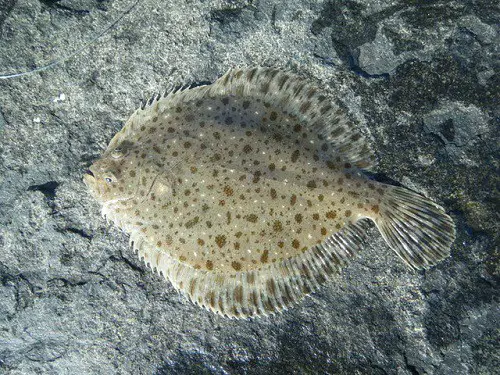
Image source: flickr.com
How Do You Prepare Flounder?
The most popular methods of preparing this mild, sweet fish are frying, sauteing, broiling, and baking. If you’re up for something more exotic, fear not; there are countless flounder recipes from around the world you can choose from.
What Is a Halibut?
Since ‘flounder’ is a general term for flatfish, the halibut is technically a flounder. Halibut refers to more than one species, although there are only two species properly covered by that name. These two species are both part of the genus Hippoglossus, and belong to the right-eye flounder family. They are the largest flatfish on the globe, and the least common.
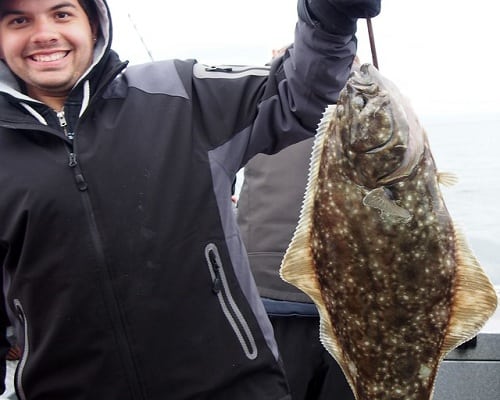
Image source: flickr.com
Common Name
This common name comes from Middle English words meaning haly(holy) and butte(flat fish), from their extensive consumption by Roman Catholics on holy days, when eating meat is not allowed. The halibut remains a popular marine food fish to this day. In some areas of the world, other species of flatfish go by the term halibut, but here we highlight the two ‘official’ species of large flatfish dwelling in the northern oceans..
Halibut Habits
Halibut, like other types of flatfish, live on the bottom of oceans and bays, although in their case they stick to the rich waters in the northern Pacific and northern Atlantic. Unlike the other species of flatfish, one type of halibut can reach over three hundred pounds, which places them among the largest of the teleost fish. They highly sought after as a food fish.Prey of halibut include most fish and crustaceans, including other flatfish and halibut; pretty much anything that they can fit inside their mouth. The eyes of these large flatfish are found on the right side of body. The top side of the halibut tends toward a mottled green or brown color, contrasting strongly with a white-ish belly. Scales are microscopic. Their curved lateral line leads to a concave tail.
Halibut Habitat
Broadly, the halibuts’ range is off the Canadian, American, Russian, and Japanese coasts, where they are pursued both by individual fisherman and commercial trawlers alike. Halibut harvesting, by international agreement, is restricted to fish over 30 inches to preserve the stocks, as these large flatfish do not reproduce until at least eight years of age.Sportsman pursue this popular fish by rod and reel, with whole salmon or herring heads hooked onto 80 to 150 pound test line. Halibut fight like mad when reeled to the surface. Fisherman usually shoot the larger halibut in the water before they are brought onboard, while smaller specimens are hauled onto the deck and clubbed. Halibut fishing is a popular pursuit in Alaska, which has a thriving commercial fishing industry. Halibut have also been an important food fish for Alaska Natives and Canadian First Nations since time immemorial.
How Do You Prepare Halibut?
Halibut meat has a firm, dense texture, and when fresh, needs very little flavoring. This fish is typically grilled, boiled, or deep fried, as the low fat content of the meat makes it a poor candidate for smoking. The meat is great for many dishes, but when purchasing halibut, it is wise to choose Pacific halibut, as opposed to the Atlantic variety, whose population has become depleted and needs time to recover.Some halibut meat has begun developing “mushy halibut syndrome.” Don’t be alarmed by the term ‘syndrome,’ because these fish are not sick. The change in the texture of the meat is most likely because of alterations in the fishes’ food sources. The ‘mushy’ fish tend to have less solid meat, in raw form, and when cooked, the meat falls apart and doesn’t flake like halibut normally should. Mushy halibut, while unappetizing to some diners, is perfectly safe to eat.
Halibut Stocks
The current Atlantic halibut stocks are depleteddue to years of over-fishing, so consumers are being urged to choose Pacific Halibut at the fish counter, so that Atlantic stocks can have time to recover and add to their numbers.
Halibut vs. Flounder
How do you tell a halibut from a flounder? Fortunately, although these fish look very similar overall, they have some distinct differences once you look closer. Read on to find out just what you are looking for.
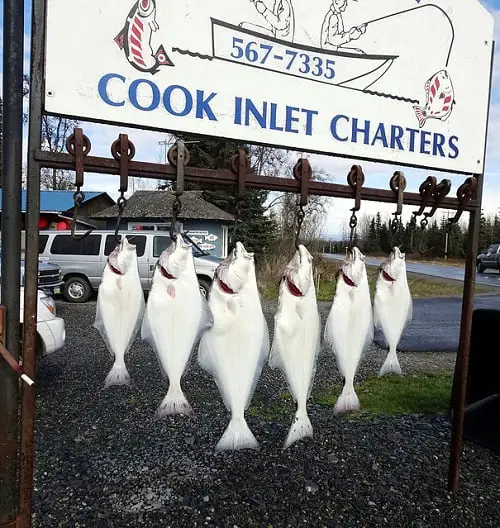
Image source: flickr.com
Main Differences
Flatfish look very similar in shape and coloring, so unless you catch a monster halibut, it seems like it is difficult to know what’s on the end of your line with the smaller fish. Don’t worry though. Once you learn their distinguishing characteristics, it’s easy. Keep in mind that halibut are the least common flatfish, and they are also caught the least. The most caught flatfish is the winter flounder, and your catch is more likely to be some other kind of flatfish, especially in warmer seas.
Size
Flounder typically top out at 37 inches long, which is a respectable size for a fish, unless you set them side by side with a mature halibut in a halibut vs flounder match up. Full grown halibut, to put it mildly, are huge. A record breaking specimen of the largest species, the Pacific Halibut, was caught off the coast of Norway in 2013, and measuring 8.6 feet and weighing in at 515 pounds, this fish was truly a giant. On average, halibut top out around 100 inches, which is much bigger than flounders which only reach about 37 inches, or a little over three feet.If your flatfish catch is significantly over three feet, you are probably looking at a halibut, but if the flatfish you reeled in is under three feet, differentiating between the small halibut vs flounder becomes a little trickier, but not by much. Just keep your eyes open and look more closely.
Lateral Lines
A curved lateral line indicates a halibut, while many flounder have a straight lateral line. Some flounder species do have a curved lateral line, so its presence is not a tie breaker. If the lateral line on your catch is straight, though, congratulations, you have caught a flounder.
Mouth & Teeth
For mouths and teeth, the difference is easy to spot, and a good way to end the halibut vs flounder debate. Halibut have large mouths, with conical teeth that stay tucked in the mouth. Flounder have a small mouth, and teeth that protrude a little.
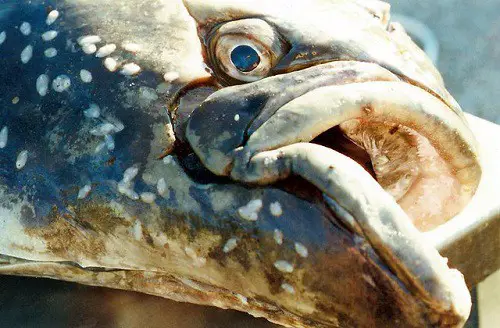
Image source: flickr.com
Tail
One of the most obvious differences, when you are trying to decide halibut vs flounder, is the tail. The halibut has a wider tail, with angled sides, and somewhat concave end. Flounder species have a narrower, straighter tail, convex at the end.
Scales
Scales also come up in the halibut vs flounder debate. Halibut have much smaller scales than flounder, and smooth skin, so the scales are not as easy to see. Flounder have thicker, more obvious scales.
Eyes
Halibut always have their eyes on the right while flounder eyes can migrate to the left instead.
Conclusion
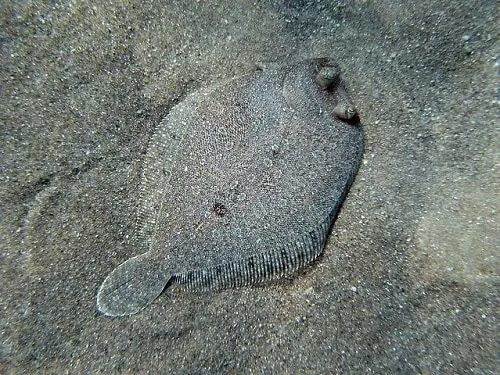
Image source: flicker.com
Now you know that determining halibut from flounder is straightforward and fairly obvious, you can be confident in your species identification when it comes to halibut vs flounder. Just remember, the differences in size, lateral line, mouth size, teeth, tail shape, scales, and eye position. Remember that there are limiting factors, too, with halibut ranging northern waters, but flounder are found all over the world. If you are really not sure you can always check the texture of the meat. Whichever fish ends up as your dinner, you are sure to have a tasty meal.

